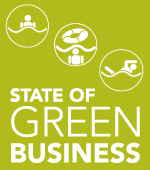How to Spur Behavior Change to Promote Sustainable Consumers
<p>Despite the wide array of sustainability initiatives companies are undertaking on their own operations, perhaps the biggest challenge to scaling up global sustainability efforts is convincing end users to reduce their own impacts.</p>

The final morning session of Day 2 of the San Francisco State of Green Business Forum brought together Andrew Williamson, the director of venture capital firm Physic Ventures; Samantha Skey of RecycleBank; and Glyn Roberts, the Director of Disruptive Sustainability at Unilever, to talk about how ways that end-users are the key, as well as the obstacle, to ramping up sustainability.
Part of the challenge that both of these groups face is that the only way the world can achieve its needs of reducing greenhouse gas emissions and averting the worst of climate change is by changing consumer behavior.
And with another billion people expected to be added to the world's population by 2020, the importance -- and urgency -- is all the more obvious.
Adding to the global consumer market takes on special prominence for a company like Unilever, which has set three goals to reduce the environmental really big challenges, including cutting the environmental footprint of their products in half. That's because, according to Roberts, 50 percent of Unilever's entire carbon footprint is due to showers taken by their customers.
That's 33 million tons of greenhouse gas emissions, every year, that the company has minimal control over. On top of showers, how customers wash their laundry also has a huge impact on Unilever's footprint, hence the company's efforts to design new products that work better under less resource-intensive settings.
"You can't do behavior change with advertising and promotions," Roberts said, "you can only do it through changing the technology."
While Unilever is changing the technology (and to some extent, working on educating customers about the impacts of their behaviors), Recyclebank is focused on rewarding customers for the behavior changes they do make.
Because the majority of people -- and RecycleBank's Chief Revenue Office Samantha Skey said the company is aimed squarely at "mainstream moms" -- see sustainability and green efforts as intimidating or even alienating, Recyclebank focuses on encouraging simple changes.
"We're approaching this as the carrot, not the stick," Skey explained. "We celebrate what consumers are doing already, and nudge them a little further along the ecospectrum so they can enjoy and appreciate what they do day to day."
The company has its roots in building up recycling infrastructures in cities across the country, but they're expanding efforts to do more rewards-based projects, whether that's rewarding people for recycling specific products or working with cities and waste hauling companies to developing programs to integrate radio-frequency ID chips to track and measure how much individual families are recycling.
Creating a clear feedback loop about how much waste people are recycling, and especially by comparing one family's recycling rates with their neighbors', is a hugely effective way to boost recycling rates as well as environmental awareness.
Ramping up activity at the end of a product lifecycle is one key, but changing behavior at the beginning is just as important. Roberts estimated that simply switching to low-flow shower heads across the U.S. would save more than 314 billion gallons of water per year, enough to supply Africa with water for 25 years. And by cutting back the length of the average shower by one minute, the country would save 12 billion gallons of water every year.
A short clip from the session is below; you can watch the full video online at GreenBiz.com.
Photo by Goodwin Ogbuehi, http://flickr.com/photos/yoshikatsu.






